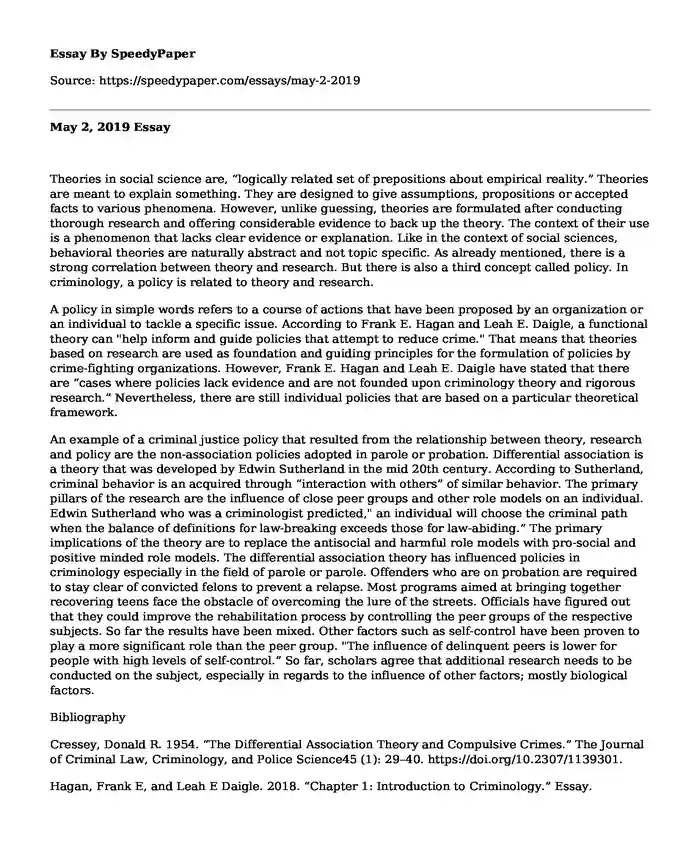Theories in social science are, "logically related set of prepositions about empirical reality." Theories are meant to explain something. They are designed to give assumptions, propositions or accepted facts to various phenomena. However, unlike guessing, theories are formulated after conducting thorough research and offering considerable evidence to back up the theory. The context of their use is a phenomenon that lacks clear evidence or explanation. Like in the context of social sciences, behavioral theories are naturally abstract and not topic specific. As already mentioned, there is a strong correlation between theory and research. But there is also a third concept called policy. In criminology, a policy is related to theory and research.
A policy in simple words refers to a course of actions that have been proposed by an organization or an individual to tackle a specific issue. According to Frank E. Hagan and Leah E. Daigle, a functional theory can "help inform and guide policies that attempt to reduce crime." That means that theories based on research are used as foundation and guiding principles for the formulation of policies by crime-fighting organizations. However, Frank E. Hagan and Leah E. Daigle have stated that there are "cases where policies lack evidence and are not founded upon criminology theory and rigorous research." Nevertheless, there are still individual policies that are based on a particular theoretical framework.
An example of a criminal justice policy that resulted from the relationship between theory, research and policy are the non-association policies adopted in parole or probation. Differential association is a theory that was developed by Edwin Sutherland in the mid 20th century. According to Sutherland, criminal behavior is an acquired through "interaction with others" of similar behavior. The primary pillars of the research are the influence of close peer groups and other role models on an individual. Edwin Sutherland who was a criminologist predicted," an individual will choose the criminal path when the balance of definitions for law-breaking exceeds those for law-abiding." The primary implications of the theory are to replace the antisocial and harmful role models with pro-social and positive minded role models. The differential association theory has influenced policies in criminology especially in the field of parole or parole. Offenders who are on probation are required to stay clear of convicted felons to prevent a relapse. Most programs aimed at bringing together recovering teens face the obstacle of overcoming the lure of the streets. Officials have figured out that they could improve the rehabilitation process by controlling the peer groups of the respective subjects. So far the results have been mixed. Other factors such as self-control have been proven to play a more significant role than the peer group. "The influence of delinquent peers is lower for people with high levels of self-control." So far, scholars agree that additional research needs to be conducted on the subject, especially in regards to the influence of other factors; mostly biological factors.
Bibliography
Cressey, Donald R. 1954. "The Differential Association Theory and Compulsive Crimes." The Journal of Criminal Law, Criminology, and Police Science45 (1): 29-40. https://doi.org/10.2307/1139301.
Hagan, Frank E, and Leah E Daigle. 2018. "Chapter 1: Introduction to Criminology." Essay. In Introduction to Criminology, 10th ed., 1-27. Thousand Oaks, California: SAGE Publications.
Libretexts. 2019. "7.6A: Differential Association Theory." Social Sci LibreTexts. Libretexts. April 27, 2019. https://socialsci.libretexts.org/Bookshelves/Sociology/Book:_Sociology_(Boundless)/7:_Deviance,_Social_Control,_and_Crime/7.6:_The_Symbolic-Interactionalist_Perspective_on_Deviance/7.6A:_Differential_Association_Theory.
Rokven, Josja J, Gijs De Boer, Jochem Tolsma, and Stijn Ruiter. 2016. "How Friends' Involvement in Crime Affects the Risk of Offending and Victimization." European Journal of Criminology14 (6): 697-719. https://doi.org/10.1177/1477370816684150.
Schutt. 2005. "Theory in Social Science." Madison. jpiliavi; 357. https://www.ssc.wisc.edu/~jpiliavi/357/theory.white.pdf.
Cite this page
May 2, 2019. (2022, Dec 30). Retrieved from https://speedypaper.net/essays/may-2-2019
Request Removal
If you are the original author of this essay and no longer wish to have it published on the SpeedyPaper website, please click below to request its removal:
- Cold War - Free Writing Assignment Example
- Males Are More Charitable Than Females - Free Essay on Gender Differences
- Essay Sample Containing Jesse Jackson Speech Analysis
- Free Essay on Public Opinion on Religion in America
- Hospital Policy: Facility Management. Free Essay Sample for Students.
- Latino Participation in the World War II, Essay Example for Everyone
- Paper Example: Fall Prevention Programs
Popular categories





